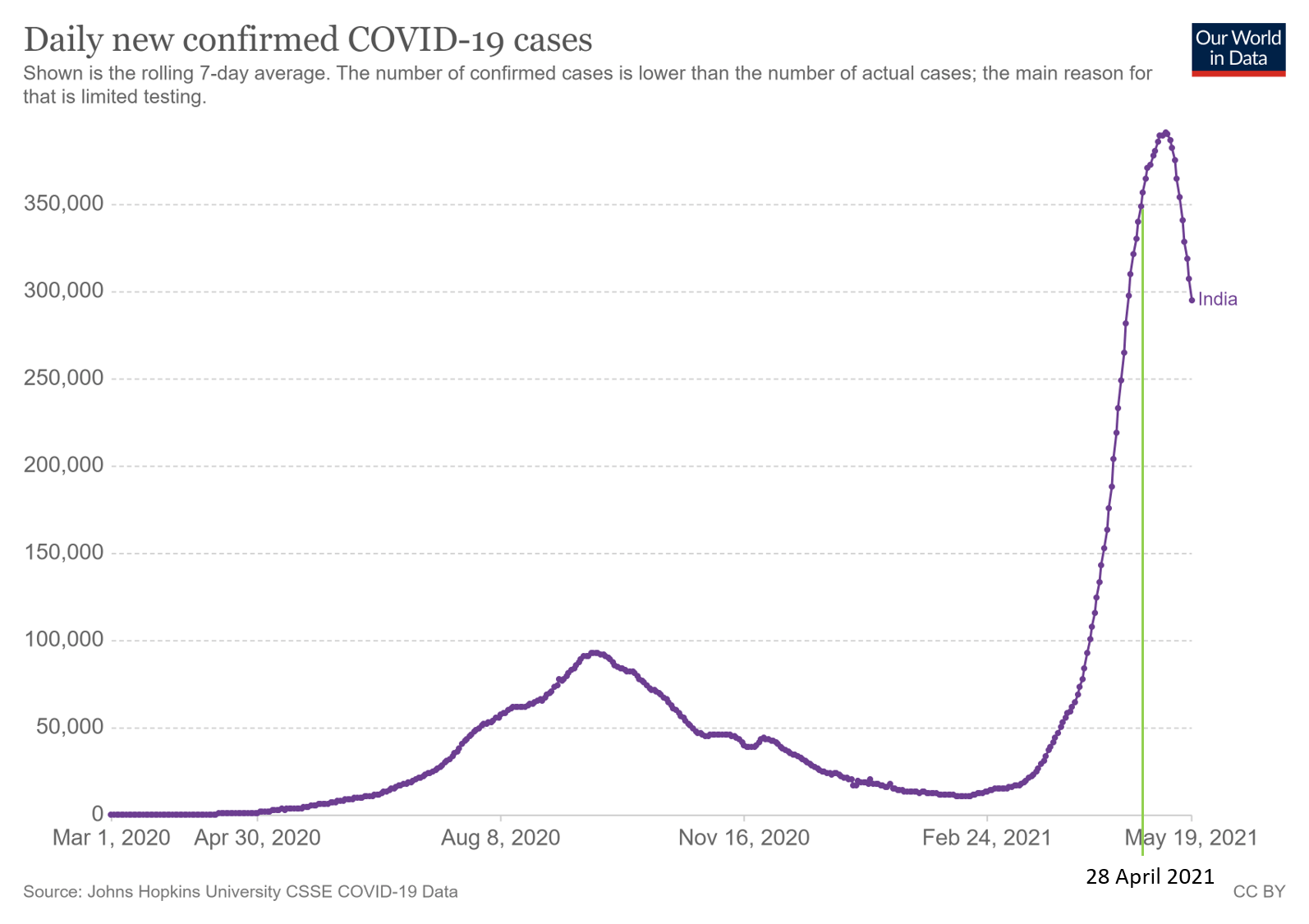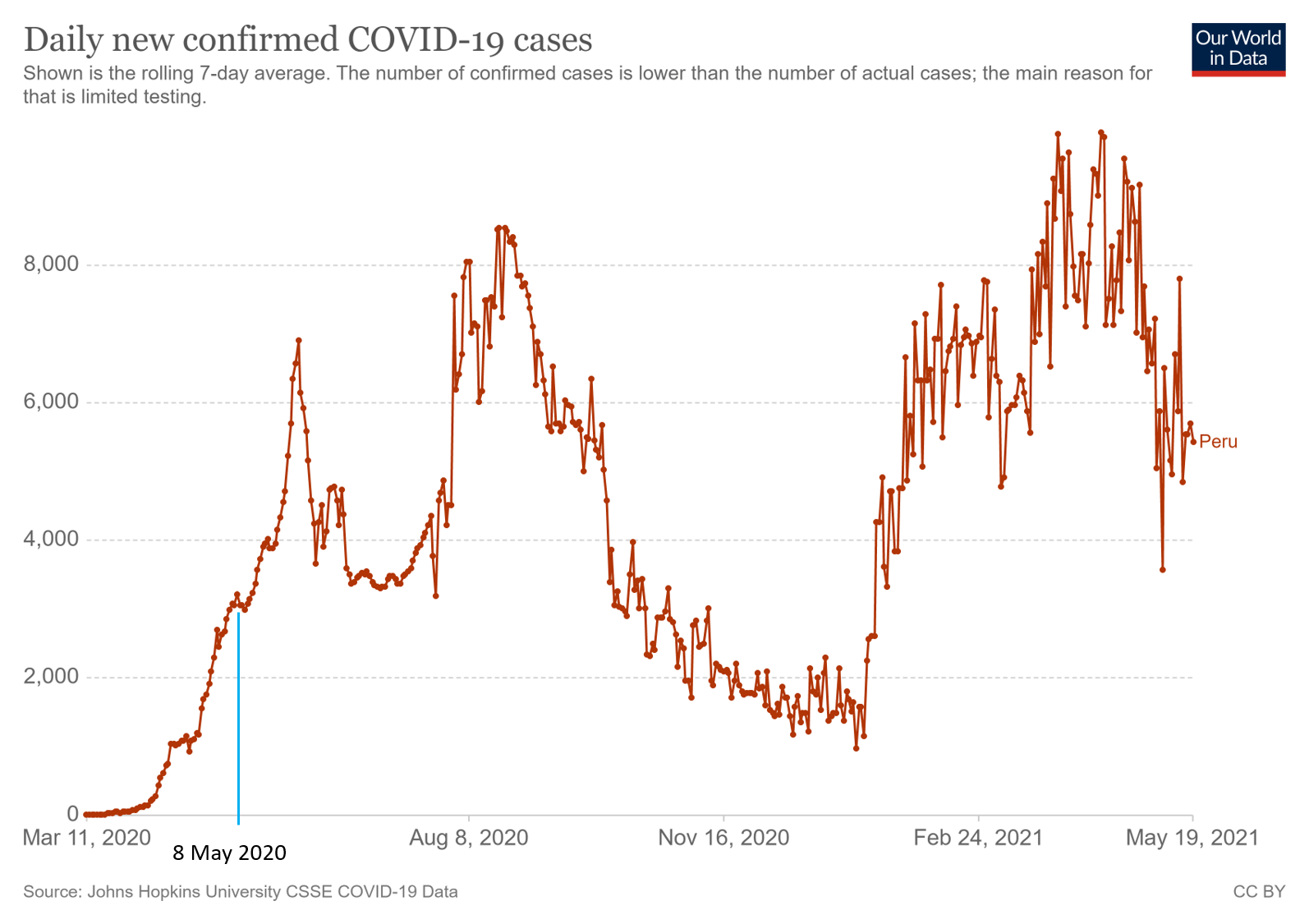
Flawed reasoning: If ivermectin were responsible for the reduction of cases, the slow down of disease spreading should be observed after the guidelines’ release.

BEHAUPTUNG: “Coronavirus cases are plummeting in India thanks to new rules that promote Ivermectin and hydroxychloroquine to its massive population”; it is a “now-indisputable fact that [ivermectin and hydroxychloroquine] essentially kill COVID-19 within hours or days”
REVIEW
Starting mid-March 2021, India experienced a massive second wave of COVID-19 cases. As of 20 May 2021, there have been more than 25 million confirmed cases and almost 300,000 registered deaths in India since the beginning of the COVID-19 pandemic.
In the midst of this second wave, the Indian Council of Medical Research updated its COVID-19 guidelines on 17 May 2021 and started suggesting ivermectin or hydroxychloroquine as optional treatments for mild COVID-19 cases. Both ivermectin and hydroxychloroquine were touted as potential treatments for COVID-19. However, international health agencies such as the World Health Organization pointed out the lack of clinical evidence supporting such expectations.
An earlier guideline issued by India’s Ministry of Health & Family Welfare from 28 April 2021 also suggested that ivermectin treatment could be used for patients with mild COVID-19 and hydroxychloroquine could be used by close contacts and caregivers of COVID-19 patients to prevent COVID-19 (prophylaxis). Hydroxychloroquine had been included in India’s guidelines as prophylaxis since at least May 2020, but ivermectin was only recently added to the guidelines this year.
According to the data analysis and visualization site Our World in Data, which collects health data from official sources, the number of daily new COVID-19 in India peaked on 9 May 2021 and began to decline since then (Figure 1). Observing the short time window between ivermectin’s addition to the guidelines and the reduction in cases, some media outlets such as the Gateway Pundit claimed that “Coronavirus cases are plummeting in India thanks to new rules that promote Ivermectin and hydroxychloroquine to its massive population”. However, such a claim is unsupported by epidemiological and clinical evidence, as we explain below.

Figure 1: Daily number of confirmed COVID-19 cases in India as of 20 May 2021. The green vertical bar indicates the release date of India’s guideline mentioning ivermectin.
According to official documents, ivermectin was included in India’s guideline as a possible treatment for mild COVID-19 as early as 28 April 2021. The daily number of COVID-19 cases started to decrease on 8 May 2021 after a sharp increase. However, the fact that event B occurs after event A isn’t enough to show that A caused B. Making this assumption without any further evidence is called the post hoc ergo propter hoc fallacy. In this case, Gateway Pundit didn’t provide evidence to prove that the inclusion of ivermectin in the guideline caused the decline in new cases. Therefore, their claim is unsubstantiated.
In order to support their claim, there are several lines of inquiry that need to be investigated. For instance, while there is a suggestion to use ivermectin for mild COVID-19 cases, we don’t know whether this has indeed translated into a greater use of ivermectin for mild COVID-19 throughout the country. Given the short span of time between the release of the guideline and the beginning of the decline in daily cases, specifically ten days, as well as the significant size of India’s territory and population, it seems highly unlikely that this guideline would have led to a nationwide uptake of ivermectin by a significant enough number of patients to already impact the evolution of the daily number of new cases.
Furthermore, ivermectin is included in the guidelines as a treatment, meaning that it would be used on people who already developed COVID-19, and are therefore considered as COVID-19 cases. Even if ivermectin worked as a treatment, its effects would be to reduce the number of severe COVID-19 cases and deaths. But it wouldn’t cause the number of new COVID-19 cases to fall, since a treatment wouldn’t prevent new cases from occurring. Therefore, the reduction in the number of COVID-19 cases cannot be attributed to the purported effectiveness of ivermectin.
If the reduction in COVID-19 cases were due to ivermectin, then we wouldn’t expect to see any sign of improvement until after the release of the updated guidelines. However, the data show a reduction in the reproduction number, known as R, starting from 16 April 2021 (Figure 2). The reproduction number R represents how many people an infected person will go on to infect on average. The higher R is, the faster and more broadly the disease will spread. If R falls below 1, the number of new cases in the population will also fall.

Figure 2: Estimate of the reproduction number R of COVID-19 in India as of 20 May 2021. The Vertical green bar represents the release date of India’s guideline mentioning ivermectin.
The R number for India was estimated at 1.46 on 16 April 2021 and decreased to 0.97 as of 15 May 2021. Given that fewer new cases of infection were occurring, we would expect to observe a reduction in reported cases, as seen since 8 May 2021. Since R began decreasing before the new guidelines were issued, the reduction in cases cannot be due to ivermectin treatment. This observation contradicts the claim by Gateway Pundit.
If ivermectin had an effect in curbing the spread of COVID-19, one might expect to only see limited contagion in countries that officially recommended this drug. Peru recommended ivermectin for mild COVID-19 as early as 8 May 2020. Official support for this drug also occurred in other countries in Latin America. However, these countries have experienced multiple waves of COVID-19 cases and deaths throughout 2020 and 2021 despite the ivermectin recommendation in place (Figure 3). Peru withdrew its recommendation in March 2021.

Figure 3: Daily number of daily confirmed cases in Peru as of 20 May 2021. The vertical blue bar represents the day of release of Peru’s guideline recommending ivermectin.
As shown earlier, the epidemiological data doesn’t support the claim that ivermectin recommendation in India slowed the spread of the disease or reduced its death toll. In addition, clinical data don’t support the claim that ivermectin is effective for treating COVID-19. Many clinical studies and trials have been performed or are underway. However, few of them are designed in a way that would provide robust evidence. Health Feedback explained in several fact-checks that most of these studies are inconclusive because they were at high risk of bias.
Bias in clinical studies may stem from an insufficiently large number of volunteers in the study, an inadequate randomization of volunteers between the test group which receives ivermectin and the control group, lack of control group altogether, or lack of blinding. Blinding in the process by which doctors and volunteers are made unaware of who receives ivermectin and who receives a standard treatment. Lack of blinding may lead to overestimation or under-estimation of subjective clinical outcomes such as symptom resolution.
Upon reviewing the available data, the World Health Organization (WHO) concluded in March 2021:
“The evidence on whether ivermectin reduces mortality, need for mechanical ventilation, need for hospital admission and time to clinical improvement in COVID-19 patients is of ‘very low certainty.’ due to “the small sizes and methodological limitations of available trial data, including a small number of events.”
Therefore, the WHO recommended that ivermectin use in COVID-19 patients should be restricted to clinical trials assessing the drug’s efficacy. In the same month, the European Medicines Agency also advised against using IVM for the general population owing to the lack of scientific proof of its efficacy.
The U.S. Food and Drug Administration adopted a similar position in May 2021. Scientific societies such as the infectious Diseases Society of America reviewed the data, focusing on the clinical studies and trials of higher quality. They too recommended “against ivermectin for the treatment of outpatients with COVID-19, unless in the context of a clinical trial“ and added: „well-designed, adequately powered, and well-executed clinical trials are needed to inform decisions on treating COVID-19 with ivermectin.” This shows that the Gateway Pundit claim that it is a “now-indisputable fact that [ivermectin and hydroxychloroquine] essentially kill COVID-19 within hours or days” is false.
In summary, neither the epidemiological nor the clinical data support the claim that the reduction in COVID-19 cases in India is due to the use of ivermectin. Media outlets making that claim based this solely on temporal correlation without providing evidence of a causal relationship. Contradicting this claim, epidemiological data show that contagiousness began to decrease in India before the release of new official guidelines recommending the use of ivermectin.


